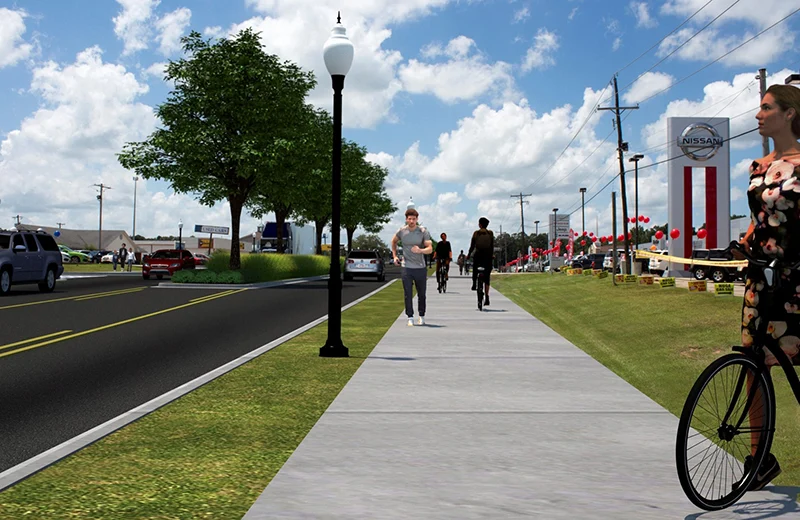
Dave Roberts, PLA, ASLA
Senior Vice President - Planning & Business DevelopmentMultimodal Transportation
In 2009, Congress passed the Complete Streets Act aiming to design streets that support mobility for users of all ages and abilities, whether drivers, cyclists, pedestrians, or passengers. The official definition from the U.S. Department of Transportation states, “The concept of Complete Streets encompasses many approaches to planning, designing, and operating roadways and rights of way with all users in mind to make the transportation network safer and more efficient.” Not all roads should be multimodal; it depends on vehicular speed, travel volume, and other safety factors. However, a thriving roadway network and a non-motorized transportation network, which often include Complete Streets, need not be mutually exclusive.
The Federal Highway Administration (FHWA) not only oversees and maintains our highways, bridges, and tunnels but also aids state and local agencies in their efforts to improve safety, mobility, livability, and innovation. According to the Arkansas Department of Transportation (ARDOT), “FHWA encourages communities to plan for multiple modes of transportation and a Complete Streets or Smart Growth model can help.” They go on to explain that “Development patterns that result, including roadway placement and design, encourage walking, bicycling and transit use while continuing to accommodate motor vehicles.”
When a city sets out to incorporate multimodal transportation, there are several factors to consider. Having worked with several municipalities on ways to implement these elements, we have found accessibility, equity, health, and sustainability to be the most compelling reasons given for considering Complete Street policies.

Accessibility
Complete Streets separate users traveling at different speeds, making it safer for those who operate at a slower pace or require more room to maneuver equipment such as wheelchairs or walkers. For these reasons, as well as the health benefits listed above, the AARP, who advocate for equity in accessibility for their more than 38 million members, supports the Complete Streets Initiative. You may hear the term 'Safe Streets’ used in place of Complete Streets, which results from the focus on separated modes of travel and accessibility. Crafton Tull has experience incorporating several of these principles into municipal comprehensive plans. We have worked with transportation agencies to receive guidance on the best ways to accommodate more vulnerable residents while continuing improvements on existing infrastructure.

Equity
When the City of El Dorado, AR commissioned Crafton Tull to create a community-engaged master plan to accommodate the expansion of the US 82B corridor through an economically and socially diverse area of town, we knew the vital role citizen input would play in creating an environment that would strengthen both the public and private realm. We worked closely with residents, business owners, elected officials, and ARDOT to determine a street cross section that would include non-vehicular modes of transportation, minimize impact to existing structures, and incorporate Complete Streets principles.
One of the cornerstones of the Complete Streets model is the idea that age, physical ability, and income levels should not determine access to transportation. In an article published in The Nation's Health a publication of the American Public Health Association (APHA) in August of 2018, Julia Haskins explains how “A community that promotes health equity provides adequate modes of transportation for all users. Pedestrians, public transit riders, bicyclists and others can all get around safely and easily in such an environment.” She goes on to make the case that “A complete streets approach ensures that such mobility conditions are met, making for more liveable communities.” The idea is that a community’s most financially disadvantaged residents should have the same level of mobility as residents who can purchase and maintain a personal vehicle.

Health
Improved health is one of the most substantial benefits of implementing Complete Streets in your town. Increased walking and bicycling is known to be highly effective in reducing the risk of obesity. The addition of bicycle and pedestrian facilities is integral to the Complete Street model. Smart Growth America cites a study finding that “43 percent of people with safe places to walk within 10 minutes of home met recommended activity levels, while just 27 percent of those without safe places to walk were active enough.”
In addition to the health benefits of increased movement, multiple modes of transportation offer greater access to healthy food options not always available to all areas of the community. A quick visit to the National Complete Streets Coalition (NCSC) website’s Partners page shows that many of the Country’s leading healthy living organizations, including the American Public Transportation Organization (APTA) and the American Heart Association (AHA), are part of the extensive collection of advocates and transportation professionals that make up the NCSC.
Sustainability
According to Smart Growth America, “Complete Streets are a natural complement to sustainability efforts, ensuring benefits for mobility, community and the environment.” A great example of the low-impact development approach to dealing with stormwater runoff is the Little Rock Main Street water quality design, for which we received the 2016 American Council of Engineering Companies (ACEC) of Arkansas Grand Conceptor Award. By providing space for low emissions (non-motorized) travel options, Complete Streets align with environmental efforts to reduce air pollution. Aside from environmental sustainability, cities should also consider fiscal sustainability when installing infrastructure to a new growth area of town. The cost to add bike lanes or a wide multi-use path, if the right of way can accommodate all facilities, is nominal compared to the cost to retrofit that same infrastructure at a later date.
Our experience navigating the often complex process of planning, designing, and building Complete Streets means that we are well-qualified to help municipalities of all sizes begin the process.